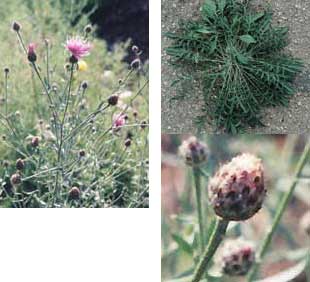Spotted Knapweed
Centaurea stoebe L. ssp. micranthos and Centaurea x psammogena (Spotted x diffuse knapweed hybrid)
Keys to Identification
- Spotted knapweed is a biennial member of the Sunflower Family (Asteraceae)
- This plant can be distinguished from its close relative Diffuse knapweed, by the lack of a terminal spine at the tip of its bracts
- Although heavy in some parts of Colorado, this plant has not yet invaded some areas of the state
This information courtesy of the Colorado Natural Areas Program
Family
Sunflower (Asteraceae)
Other Names
None widely accepted.
USDA Code
CEMA4
Legal Status
Colorado Noxious Weed List B
Identification
Lifecycle
Biennial or short-lived perennial.
Growth form
Forb
Flower
Flowering heads are solitary at the ends of branches. The floral bracts are stiff and tipped with a dark comb-like fringe. The flowers are pinkish-purple or rarely cream colored.
Seeds/Fruit
Seeds have a tuft of persistent bristles.
Leaves
Rosette leaves are up to 6 in long, and deeply lobed. The principal stem leaves are pinnately divided, have smooth margins, and become smaller toward the top of the shoot. Leaves are alternate.
Stems
Mature plants are 1-3 ft tall with one or more stems.
Roots
Spotted knapweed has a stout taproot.
Seedling
Rosettes of spotted and diffuse knapweed are nearly indistinguishable. Leaves are narrow and 1-2 times pinnately divided (Stubbendieck et al. 1995).
Other
Closely related to diffuse knapweed(Centaurea diffusa).
Similar Species
Exotics
Other knapweeds include diffuse knapweed(Centaurea diffusa)which has a distinct terminal spine on the floral bracts, Russian knapweed(Centaurea repens)whose flowers are smaller than those of spotted knapweed and do not have black mottling on the flower bracts, and squarrose knapweed(Centaurea virgata).
Natives
None known.
Impacts
Agricultural
Spotted knapweed reduces or displaces desirable plant species, thereby reducing livestock and wildlife forage (Sheley et al. 1999).
Ecological
Spotted knapweed is a highly competitive weed that invades disturbed areas and degrades desirable plant communities. It forms near monocultures in some areas of western North America (FEIS 1998). There is evidence that spotted knapweed may produce allelopathic chemicals that inhibit the growth of other plants (Rutledge and McLendon, 1998). Spotted knapweed infestations in Montana had higher surface water runoff and higher sediment yields than bluebunch wheatgrass-dominated sites (Lacey et al. 1989).
Human
The sap of spotted knapweed can cause skin irritation in some people. As a precaution, anyone working with spotted knapweed should wear protective gloves and avoid getting knapweed sap into open cuts or abrasions. Workers should wash their hands and exposed skin with soap and water following contact with this plant.
Habitat and Distribution
General requirements
Spotted knapweed is adapted to well-drained, light to coarse-textured soils that receive summer rainfall (FEIS 1998, Rutledge and McLendon, 1998). Spotted knapweed is not tolerant of shade. It tends to inhabit somewhat moister sites than diffuse knapweed, preferring areas that receive 12 to 30 in annual precipitation.
Distribution
Spotted knapweed infestations are not as severe in Colorado as diffuse knapweed (Beck 1997). However, this weed spreads rapidly and is quickly becoming more common. In Colorado, it is commonly found between 4,000 to 6,000 feet, but has been found as high as 10,000 feet (A. Green, pers. comm.).
Historical
Native to central Europe.
Biology/Ecology
Life cycle
Spotted knapweed germinates in spring or fall (Beck 1997). Spotted knapweed seedlings develop into and remain as rosettes for at least one growing season while root growth occurs (FEIS 1998). It usually bolts for the first time in May of its second growing season and flowers August through September (Rutledge and McLendon, 1998). Individual flowers bloom for 2-6 days (FEIS 1998). Plants are self fertile and are also cross-pollinated by insects.
Mode of reproduction
Seed.
Seed production
Plants may produce up to 140,000 seeds per square meter (Rutledge and McLendon, 1998). Most seeds are shed immediately after reaching maturity.
Seed bank
Spotted knapweed seeds exhibit three germination behaviors: dormant light-sensitive, dormant light insensitive, and non-dormant (FEIS 1998). Dormant seeds form a seed bank and may remain viable in the soil for over 8 years (Rutledge and McLendon, 1998).
Dispersal
Knapweed seeds are often spread in hay and on vehicle undercarriages.
References
FEIS – Fire Effects Information System [Online] (1996, September). Prescribed Fire and Fire Effects Research Work Unit, Rocky Mountain Research Station (producer), US Forest Service. Available: www.fs.fed.us/database/feis/ [1998,March 12]
Beck, G.K. 1997. Natural resource series, diffuse and spotted knapweed. Colorado State University Cooperative Extension no. 3.110. Internet 05/05/98. Available: http://ozma.jeffeson.co.us/dpt/opennspac/weed/dfknapweed.htm
Davis, E.S. 1990. Spotted knapweed (Centaurea maculosa) seed longevity, chemical control and seed morphology. M.S. Thesis, Montana State University, Bozeman, MT.
Fletcher, R.A. and A.J. Renney. 1963. A growth inhibitor found in Centaurea spp. Canadian Journal Of Plant Science 43:475-481.
Lacey, J.R., C.B. Marlow and J.R. Lane. 1989. Influence of spotted knapweed (Centaurea maculosa) on surface water runoff and sediment yield. Weed Technology 3:627-631.
Lacey, C.A., J.R. Lacey, P.K. Fay, J.M. Stry and D.L. Zamora. 1995. Controlling spotted knapweed in Montana rangeland. Circular 311. Montana State University Cooperative Extension, Bozeman, MT.
Olson, B.E., R.T. Wallender, and J.R. Lacey. 1997. Effects of sheep grazing on a spotted knapweed infested Idaho fescue community. Journal of Range Management 50:386-390.
Mauer, T., M.J. Russo, and M. Evans. 1998. Element Stewardship Abstract for Centaurea maculosa. The Nature Conservancy. Internet 07/28/98. Available: http://tncweeds.ucdavis.edu/esadocs/documnts/centmac.html
Rutledge, Chris R. and Dr. Terry McLendon. No Year. An Assessment of Exotic Plant Species of Rocky Mountain National Park. Department of Rangeland Ecosystem Science, Colorado State University. 97pp. Northern Prairie Wildlife Research Center Home Page. http://www.npwrc.usgs.gov/resource/othrdata/explant.htm (Version 15DEC98).
Sheley, R.L., and J.S. Jacobs. 1997. “Acceptable” levels of spotted knapweed (Centaurea maculosa) control. Weed Technology 11:363-368.
Stubbendieck, J., G.Y. Friisoe and M.R. Bolick. 1995. Spotted knapweed. Weeds of Nebraska and the Great Plains. Nebraska Department of Agriculture, Bureau of Plant Industry, Lincoln, Nebraska. pg. 103.
Watson, A.K., and A.J. Renney. 1974. The biology of Canadian weeds Centaurea diffusa and C. maculosa. Canadian Journal of Plant Science 54:687-701.
Whitson, T.D.(ed.), L.C. Burrill, S.A. Dewey, D.W. Cudney, B.E. Nelson, R.D. Lee, R. Parker. 1996. Spotted knapweed. Weeds of the West. Western Society of Weed Science, in cooperation with the Western United States Land Grant Universities Cooperative Extension Services, Newark CA. pg. 88.


